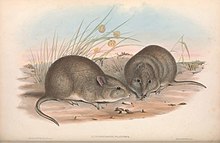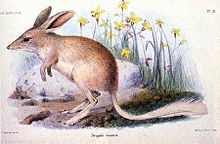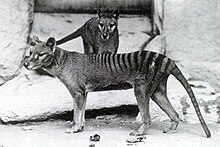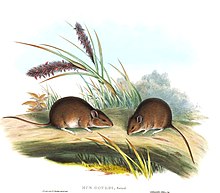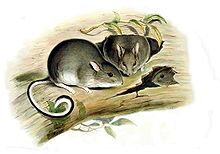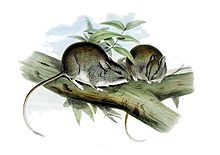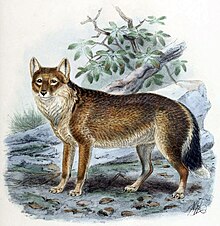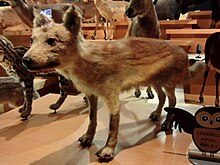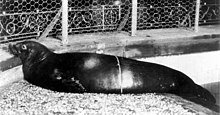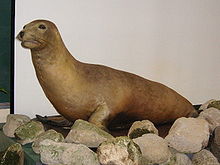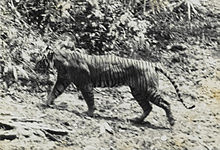List of modern extinct mammals
The Red List of endangered species of the IUCN in 2019 lists 81 species of mammals that have become extinct since the year 1500 or presumed extinct. In addition, numerous species are listed in the categories “ critically endangered ” or “insufficient data” ( data deficient ) that have either not been proven for decades or are only known from an older holotype . Some extinct taxa are not even included in the Red List. The majority make up the rodents with 38 kinds, followed by the marsupials with 13 kinds, the Cetartiodactyla with 13 kinds and the predators with 8 kinds. In Australia, where 28 species are extinct, the mammals were hardest hit by the extinction wave. Since the European settlers began to colonize the country in the 18th century, more and more marsupials and rodents have gradually disappeared, be it through overhunting, loss of habitat or through the importation of non-faunal predators such as the red fox or the marten , to which the endemic mammalian fauna attach itself Australia couldn't adapt quickly enough. In Tasmania , the thylacine was considered a pest until the early 1930s. By the time he was placed under protection, it was already too late. The last specimen died in Hobart Zoo in 1936 . In the Caribbean, where 22 species have become extinct, not only humans, feral cats and rats were responsible for the disappearance of rodents and insectivores, but also volcanic eruptions, such as that of the Montagne Pelée in Martinique in 1902. In South Africa the large grazers were like the quagga or the blue goat are regarded as competition for the herds and accordingly persecuted mercilessly. Predators such as atlas bears , barber lions and cape lions were also exterminated as a potential threat to humans and grazing cattle. In Indonesia and the Philippines, many rodents are considered a delicacy. Some of them, like the Ilin bark rat, are only known from the holotype and are believed to have been overhunted. Climate change is also a threat for the future. It may already have played a role in the extinction of the Telefomin cuscus ( Phalanger matanim ). It was only known from a very small area in the Telefomin District in Papua New Guinea, which was completely destroyed by drought, night frost and fire. Several rodent taxa on islands were also unable to develop defensive strategies against the invasive rats and the pathogens they brought in and quickly disappeared from their habitats. Steller's manatee was eradicated for its meat and skin just a short time after it was discovered.
List of mammal species and subspecies extinct after 1500
Marsupials
Climbing bag
- Telefomin couscous ( Phalanger matanim ) (Papua New Guinea, 1990s?)
- Discovered in 1985 and no longer detected in the early 2000s.
Kangaroos
- Central Australian rabbit kangaroo ( Lagorchestes asomatus ) (Australia, probably between 1940 and 1960)
- only known from one specimen from 1932.
- Eastern rabbit kangaroo ( Lagorchestes leporides ) (Australia, 1890)
- Eastern Irmawallaby ( Macropus greyi ) (Australia, 1937)
- the last specimen died in captivity in 1937
- Moon nail kangaroo ( Onychogalea lunata ) (Australia, 1956)
Rat kangaroos
species
- Nullarbor Brush Kangaroo ( Bettongia pusilla ) (Australia, early 19th century)
- This species is only known from subfossil bone material, but it may have survived until the start of the colonization of Australia by the Europeans.
- Naked-breasted kangaroo ( Caloprymnus campestris ) (Australia, 1935)
- Broad-headed kangaroo ( Potorous platyops ) (Australia, 1875)
- The last five copies were collected in 1875 and sold to the National Museum in Victoria.
- Desert brush rat kangaroo ( Bettongia anhydra ) (Australia, 1930s)
- Only known from a skull discovered in 1933 and from another subfossil skull.
Subspecies
- Eastern brush-tailed rat kangaroo ( Bettongia penicillata penicillata ) (Southeastern Australia, 1920s)
- The last evidence was in 1923.
Nasal bag
- Support bagler ( Chaeropus ecaudatus ) (Australia, between 1920 and 1930)
- the last confirmed evidence is from 1901. According to reports from the Aborigines, the animals disappeared between 1920 and 1930.
- Chaeropus yirratji (Australia)
- There were unconfirmed observations of the Aborigines until the 1950s.
- Small rabbit- nosed whisker ( Macrotis leucura ) (Australia, 1967)
- The last living specimen was seen in 1931. The last bones were discovered in 1967 in the vault of a wedge-tailed eagle.
- Desert long-nosed bucket ( Perameles eremiana ) (Australia, 1960s)
- the last copy was collected in 1943. Presumably the species survived into the 1960s.
- Perameles papillon (Australia, 1940s)
- was exterminated by foxes in the 1940s.
- Ceram nasal bag ( Rhynchomeles prattorum ) (Seram, 1920s)
- known only from seven specimens collected in 1920.
Thylacinidae
- Beutelwolf ( Thylacinus cynocephalus )
- after decades of merciless hunt, the last recorded specimen died in Hobart Zoo in 1936.
Insect eater
Caribbean shrews
The entire family died out after 1500. The following species belonged to it:
- Puerto Rican shrew ( Nesophontes edithae ) (Puerto Rico, after 1500)
- known only from subfossil material which is dated between AD 991 and 1153. However, it is possible that this species was only exterminated by rats in post-Columbian times.
- Nesophontes hemicingulus (Grand Cayman and Cayman Brac, around 1700)
- Atalaya shrew ( Nesophontes hypomicrus ) (Hispaniola, after 1500)
- known from subfossil material found in association with rat bones. This could be an indication that this species survived until the European colonization of Hispaniola in post-Colombian times.
- Nesophontes major (Cuba, after 1500)
- known from subfossil material found in association with rat bones. This could be an indication that this species survived until the European colonization of Cuba in post-Colombian times.
- Lesser Antilles shrew ( Nesophontes micrus ) (Cuba, after 1500)
- known from subfossil material found in association with rat bones. This could be an indication that this species survived until the European colonization of Cuba in post-Colombian times.
- Great Hispaniola shrew ( Nesophontes paramicrus ) (Hispaniola, after 1500)
- known from subfossil material found in association with rat bones. This could be an indication that this species survived until the European colonization of Hispaniola in post-Colombian times.
- Haiti shrew ( Nesophontes zamicrus ) (Hispaniola, after 1500)
- known from subfossil material found in association with rat bones. This could be an indication that this species survived until the European colonization of Hispaniola in post-Colombian times.
Weevil
- Hispaniola weevil ( Solenodon marcanoi ) (Hispaniola, after 1500)
- known only from subfossil material found in association with rat bones. This could be an indication that the species survived until the colonization of Hispaniola by the Europeans.
Shrews
species
- Christmas Island shrew ( Crocidura trichura ) (Christmas Island, Australia, late 1990s?)
- was already considered to be extinct around 1908 until the species was briefly rediscovered in 1985. Intensive searches since the 2000s have so far failed.
- Alaska water shrew ( Sorex alaskanus ) (Point Gustavus, Bartlett Cove, Glacier Bay, Alaska, 1970s?)
- known only from two male specimens from 1899 and one other male from 1970.
- Sherman short-tailed shrew ( Blarina shermani ) (Lee County, Florida, 1955)
- Originally considered a subspecies of the southern short-tailed shrew ( Blarina carolinensis ). Only known of 27 specimens collected in 1954.
Tenrek-like
Goldmulle
- De Winton's gold mole ( Cryptochloris wintoni ) (Namaqualand, South Africa)
- Known only from three copies.
- Visagies gold mole ( Chrysochloris visagiei ) (Northern Cape Province, South Africa)
- Known only from the 1949 holotype.
Bats
Leaf noses
- Desmodus draculae (Brazil, Argentina and Venezuela, 1795?)
- largest known species of vampire bats . Known only from subfossil material which is dated between 1482 and 1795.
Fruit bats
- Guam fruit bat ( Pteropus tokudae ) (Guam, 1968 or 1974)
- the last specimen was shot in 1968. There is said to have been an unconfirmed sighting in 1974.
- Small Mascarene Flying Fox ( Pteropus subniger ) (Réunion and Mauritius, 1864)
- the last specimen was collected in Mauritius in 1864.
- Soft-haired fruit bat ( Pteropus pilosus ) (Palau Islands, Caroline Islands, 1874)
- only known from the type material from 1874.
- Percy Island fruit bat ( Pteropus brunneus ) (Percy Island, Australia, 1859)
- only known from the holotype from 1859.
- Pteropus allenorum (Upolu, Samoa, 1856)
- only known from one museum specimen that was scientifically described only in 2009.
- Pteropus coxi (Samoa, 1840)
- only known from one museum specimen that was scientifically described only in 2009.
- Okinawa fruit bat ( Pteropus loochoensis ) (Okinawa, late 19th century)
- only known of three specimens (of which only two still exist), which were described in 1870.
- Mountain monkey-faced bat ( Pteralopex pulchra ) (Guadalcanal, Solomon Islands, 1990s?)
- known only from the holotype collected in 1990.
- Aru fruit bat ( Pteropus aruensis ) (Aru Islands, Indonesia, 1990s?)
- the last confirmed evidence was before 1867. A toothless jaw that might belong to this species was found in 1992.
New Zealand bats
- Great New Zealand bat ( Mystacina robusta ) (Stewart Island, Big South Cape and Solomon, South Island New Zealand, 1967)
- until 1967 in the last refuges by rats.
Smooth noses
- Christmas Island pipistrelle ( Pipistrellus murrayi ) (Christmas Island, Australia, 2009)
- In 2008 only 20 copies were counted. In an intensive search in 2009, no more specimens were found.
- Sturdee pipistrelle ( Pipistrellus sturdee ) (Ogasawara Islands, late 19th century)
- Known only from the holotype collected at the end of the 19th century.
- Lord Howe big-eared bat ( Nyctophilus howensis ) (Lord Howe Island, 1889)
- known subfossil from a skull that was described in 1973. There is also a travel report by Robert Etheridge from 1889, in which a bat is mentioned that is larger than Chalinolobus morio .
- Samoan water bat ( Myotis insularum ) (Samoa, 1860s)
- dubious species known only from the holotype.
- Singapore whiskered bat ( Myotis oreias ) (Singapore, before 1840?)
- known only from the destroyed holotype, which was described in 1840.
- Tsushima tube-nosed bat ( Murina tenebrosa ) (Tsushima, Japan 1960s)
- known only from the holotype from 1962.
Horseshoe bats
- Indian horseshoe bat ( Rhinolophus mitratus ) (Bihar, India, 1844)
- Known only from the holotype from 1844.
Incertae sedis
- Boryptera alba (Réunion, 1801)
- only known from a travel report from 1801.
Primates
Vervet monkey relatives
species
- Miss Waldron's red colobus monkey ( Piliocolobus waldronae ) (Ghana and Ivory Coast, 1978)
- the last reliable evidence is from 1978. However, a fresh reddish monkey fur acquired in 2001 could represent this taxon.
Subspecies
- Angolan monkey monkey ( Cercopithecus mitis mitis ) (Angola)
- Nominal form of the diademed monkey . According to 1997 mammal scientist Jonathan Kingdon , this subspecies is likely extinct.
Sakia monkeys
- Jamaican monkey ( Xenothrix mcgregori ) (Jamaica, 1769?)
- Known only from subfossil bone material, it may have survived into the early 18th century.
Gibbons
Subspecies
- Yunnan white-handed gibbon ( Hylobates lar yunnanensis ) (China, 1990s)
- Last seen in 1988. An intensive search in 2007 was unsuccessful.
Rabbit-like
Whistle hares
- Sardinian Pika ( Prolagus sardus ) (Corsica and Sardinia, 1774)
- The Sardinian Pika was last seen in 1774.
Rodents
Barbed rats
- Great Cuba spiny rat ( Boromys offella ) (Cuba, after 1500)
- known only from subfossil bone material. Presumably survived until the Europeans settled Cuba.
- known only from subfossil bone material. Presumably survived until the Europeans settled Cuba.
- Hispaniola barbed rat ( Brotomys voratus ) (Hispaniola, between 1536 and 1546)
- known from subfossil bone material from the time of the Arawak culture. A travel report by Fernandez de Oviedo y Valdez, who lived in Hispaniola between 1536 and 1546, could describe this animal.
- Puerto Rico cave spiny rat ( Heteropsomys insulans ) (Puerto Rico and Vieques, after 1500)
- known only from subfossil bone material, which is dated to the time of early European settlement.
Tree rats
species
- Cuban stubby-tailed piglet rat ( Geocapromys columbianus )
- Swan Islands Piglet Rat ( Geocapromys thoracatus )
- San Felipe Tree Rat ( Mesocapromys sanfelipensis )
- Dwarf tree rat ( Mesocapromys nanus )
- Haiti piglet rat ( Hexolobodon phenax )
- Mountain piglet-rat ( Isolobodon montanus )
- Puerto Rico piglet rat ( Isolobodon portoricensis )
- Veloz-zaguti ( Plagiodontia ipnaeum )
- Geocapromys caymanensis
Subspecies
- Capromys pilorides lewisi (Grand Cayman, Little Cayman, Cayman Brac, around 1700)
- extinct subspecies of the Hutiaconga
Long-tailed mice
species
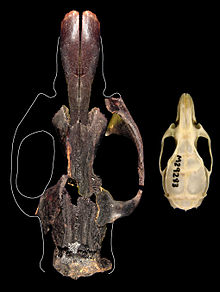
- Ethiopian water mouse ( Nilopegamys plumbeus ) (Ethiopia, 1927)
- only known from the holotype from 1927.
- Bühler rat ( Coryphomys buehleri ) (Timor, after 1500)
- known only from subfossil bone material.
- Coryphomys musseri (Timor, after 1500)
- known only from subfossil bone material.
- White-footed rabbit rat ( Conilurus albipes ) (Australia, 1845)
- The species was once considered a plague in its range. It has not been proven since 1845.
- Christmas Island rat ( Rattus nativitatis ) (Christmas Island, Australia, 1903)
- Was eradicated by trypanosomal pathogens introduced by rats.
- Maclear rat ( Rattus macleari ) (Christmas Island, Australia, 1903)
- Was eradicated by trypanosomal pathogens introduced by rats.
- Blue-gray mouse ( Pseudomys glaucus ) (Australia, 1956)
- only known of three specimens collected in 1910 and 1956.
- Gould mouse ( Pseudomys gouldii ) (Australia, 1857)
- the last evidence was between 1856 and 1857.
- Short-tailed jumping mouse ( Notomys amplus ) (Australia, 1896)
- Only known of two specimens collected in 1896.
- Great-eared mouse ( Notomys macrotis ) (Australia, 1840s)
- Only known of two specimens, one of which was collected in 1843.
- Darling Downs bouncy mouse ( Notomys mordax ) (Australia, 1840s)
- Known only from one skull found in 1845.
- Broad-cheeked jumping mouse ( Notomys robustus ) (Australia, 19th century)
- Known only from skull fragments.
- Long-tailed jumping mouse ( Notomys longicaudatus ) (Australia, 1970s?)
- The last reliable evidence dates back to 1901. However, since a skull of this type was found in an owl's bulge in 1977, the long-tailed jumping mouse could have survived much longer.
- Ilin bark rat ( Crateromys paulus ) (Ilin, Philippines, 1953)
- only known from the holotype from 1953.
- Emma giant rat ( Uromys emmae ) (Paidaido Islands, 1940s?)
- only known from the holotype from 1946.
- Imperial giant rat ( Uromys imperator ) (Guadalcanal, Solomon Islands, 1888)
- known only from three specimens collected on Guadalcanal between 1886 and 1888.
- Guadalcanal giant rat ( Uromys porculus ) (Guadalcanal, Solomon Islands, 1888)
- only known of one specimen collected on Guadalcanal between 1886 and 1888.
- Little bunny rat ( Leporillus apicalis ) (Australia, 1933 or 1970s?)
- the last reliable evidence comes from 1933. However, freshly padded nests of this species from 1970 suggest that it could have survived into the 1970s.
- only known of two specimens collected in Togo in 1890.
- Florida bareback rat ( Solomys salamonis ) (Solomon Islands, 20th century?)
- only known from the holotype from 1883.
- Bramble Cay mosaic tail rat ( Melomys rubicola ) ( Bramble Cay , 2016)
- Last unconfirmed sighting in 2009, probably extinct due to rising sea levels
- Cheesman lamellar tooth rat ( Otomys cheesmani ) (Ethiopia, 1968)
- The last evidence was in 1968.
Chinchillas
- Peru Viscacha ( Lagostomus crassus ) (Cusco, Peru, after 1500)
- known only from a skull that was unearthed in the Cusco region of Peru before 1910.
Burrower
species
- Candango mole mouse ( Juscelinomys candango ) (Brazil, 1960s)
- Only known of nine specimens collected in Brasilia in 1960.
- Martinique giant rice rat ( Megalomys desmarestii ) (Martinique, 1902)
- the last population was wiped out in 1902 when the Montagne Pelée erupted.
- Saint Lucia giant rice rat ( Megalomys luciae ) (Saint Lucia, 1881)
- was exterminated by mongooses around 1881. One specimen lived in London Zoo between 1849 and 1852.
- Barbuda giant rice rat ( Megalomys audreyae ) (Barbuda, after 1600)
- known only from subfossil bone material. Could have survived until the Europeans settled Barbudas in the early 17th century.
- Barbados giant rice rat ( Megalomys georginae ) (Barbados, 19th century)
- known only from subfossil bone material. Possible extinction period between 1847 and 1890.
- Island bush rat ( Neotoma insularis ) (Isla Angel de la Guardia, Baja California, Mexico, 1990s)
- No specimen was found during a search expedition in 1997.
- Galápagos giant rat ( Megaoryzomys curioi )
- Darwin rice rat ( Nesoryzomys darwini )
- Santa Cruz Rice Rat ( Nesoryzomys indefessus )
- Fernando de Noronha rat ( Noronhomys vespuccii )
- St. Vincent's pygmy rice rat ( Oligoryzomys victus )
- Jamaican rice rat ( Oryzomys antillarum )
- Nelson rice rat ( Oryzomys nelsoni ) (María Madre, Marias Islands, 1897)
- only known of four specimens collected on María Madre in 1897.
- Nevis rice rat ( Pennatomys nivalis ) (St. Kitts and Nevis, 1930s)
- There have been reports of rice rats on Nevis from the 17th century through the 1930s.
- Pemberton deer vole ( Peromyscus pembertoni ) (San Pedro Nelasco, Gulf of California, 1930s)
- only known of twelve specimens collected on San Pedro Nelasco in 1931.
- Puebla deer mouse (Puebla, Mexico, 1940s),
- only known of two specimens collected in 1894 and 1947.
- Zuniga's dark rice rat ( Melanomys Zunigae ) (Peru, 1940s)
- known only from the type specimens collected in 1942.
- Ekbletomys hypenemus (Antigua and Barbuda, after 1500)
Subspecies
- Gyldenstolpia fronto chacoensis (Río de Oro, Chaco Province, Argentina, 1896)
- Subspecies of the Gyldenstolpe giant rice rat ( Gyldenstolpia fronto ), only known from the holotype collected in 1896.
- Gull meadow vole ( Microtus pennsylvanicus nesophilus ) (Great Gull Island, Long Island Sound, 1898)
- Subspecies of the meadow vole ( Microtus pennsylvanicus ), discovered in 1889 and no longer detected in 1898.
- Chihuahua meadow vole ( Microtus pennsylvanicus chihuahuensis ) (Ojo Galeana, Chihuahua, Mexico, 1998)
- Subspecies of the meadow vole ( Microtus pennsylvanicus ). The last evidence was in 1998.
- Ash meadows vole ( Microtus montanus nevadensis ) (Ash Meadows, Nevada, 1933)
- Subspecies of the Rocky Mountains vole ( Microtus montanus ). The last evidence was in 1933.
- Chadwick Beach cotton mouse ( Peromyscus gossypinus restrictus ) (Florida, 1938)
- Cotton mouse subspecies ( Peromyscus gossypinus ), last sighted in 1938.
- San Miguel deer mouse ( Peromyscus maniculatus streatori ) (San Miguel Island, 1860s?)
- Ponce de Leon coast mouse ( Peromyscus polionotus decoloratus ) (Ponce de Leon, Florida, 1959)
- Subspecies of the coast mouse ( Peromyscus polionotus ), last sighted in 1959.
- Sigmodon arizonae arizonae (Camp Verde, Arizona, 1932)
- Nominal form of the Arizona cotton rat , last sighted in 1932.
- Sigmodon arizonae jacksoni (Fort Whipple, Yavapai County, Arizona, 1916)
- Subspecies of the Arizona cotton rat known only from the 1916 holotype.
- Synaptomys cooperi paludis (Kansas, 1946)
- Subspecies of the southern moor lemming , last sighted in 1946.
- Synaptomys cooperi relictus (Nebraska, 1968)
- Subspecies of the southern moor lemming , last sighted in 1968.
- Todos santos bush rat ( Neotoma bryanti anthonyi )
- Coronados bush rat ( Neotoma bryanti bunkeri )
- San Martin bush rat ( Neotoma bryanti martinensis )
Pocket rats
Subspecies
- Goff's pine pocket rat ( Geomys pinetis goffi ) (Florida, 1955)
- Subspecies of the southeastern pocket rat or pine pocket rat ( Geomys pinetis ). The last specimens were seen in 1955.
- Sherman pine pocket rat ( Geomys pinetis fontanelus ) (Georgia, 1950)
- Subspecies of the southeastern pocket rat or pine pocket rat ( Geomys pinetis ). The last specimens were collected near Savannah, Georgia in 1950.
- Thomomys bottae abstrusus (Fish Spring Valley, Nye County, Nevada, 1933)
- Subspecies of the mountain pocket rat ( Thomomys bottae ). Only known of five specimens collected in 1933.
- Thomomys bottae curtatus (San Antonio, Nye County, Nevada, 1931)
- Subspecies of the mountain pocket rat ( Thomomys bottae ). Only known of twelve specimens collected in 1931.
- Thomomys bottae subsimilis (Arizona, 1917)
- Subspecies of the mountain pocket rat ( Thomomys bottae ). Only known from the female holotype found in 1917 from the Harquahala Mountains in Arizona.
- Thomomys mazama louiei (Washington, 1956)
- Subspecies of the Mazama pocket rat ( Thomomys mazama ). Last seen in 1956. Expeditions in 1977, 1986 and 1995 could not confirm a further existence of this subspecies.
- Tacoma pocket rat ( Thomomys mazama tocomensis ) (Washington, 1962)
- Subspecies of the Mazama pocket rat ( Thomomys mazama ). The last five known specimens were collected between 1961 and 1962.
Pocket mice
Subspecies
- Perognathus alticolus alticolus ( San Bernardino Mountains , California, 1934)
- Nominate form of the white-eared pocket mouse ( Perognathus alticolus ). Last recorded in 1934.
- Dipodomys microps russeolus (Dolphin Island, Great Salt Lake, 1940s)
- Subspecies of the chisel-tooth kangaroo rat ( Dipodomys microps ). Died out in floods on Dolphin Island due to drastic water level fluctuations.
- Dipodomys californicus eximius (Marysville Buttes, California, 1983)
- Subspecies of the California kangaroo rat ( Dipodomys californicus ). Last recorded in 1983.
- Dipodomys nitratoides exilis ( Fresno County , northern San Joaquin Valley , California, 1992)
- Subspecies of the San Joaquin kangaroo rat ( Dipodomys nitratoides ). Last detected in 1992.
- Microdipodops megacephalus nexus (Humboldt County, Lander County, Nevada, 1980s)
- Subspecies of the dark kangaroo mouse . Not proven for 30 years.
croissant
Subspecies
- Tamias umbrinus nevadensis (Sheep Mountains, Nevada, 1960)
- Subspecies of the Uinta chipmunk ( Tamias umbrinus ). The last evidence was in 1960.
- Dangs giant squirrel ( Ratufa indica dealbata ) (Surat Dangs, Gujarat, India, 1945)
- Subspecies of the giant king squirrel (Ratufa indica). The last evidence was in 1945.
Cetartiodactyla
Hippos
- Hippopotamus lemerlei (Madagascar, after 1500?)
- known only from subfossil bone material, which is dated between 155 and 415 AD. Oral records suggest that it survived until after 1500.
- known only from subfossil bone material, which is dated between 640 and 1400 AD. Oral records suggest that it survived until after 1500. Eyewitness reports of alleged hippo sightings in Madagascar existed until 1976.
Deer
species
- Schomburgk deer ( Rucervus schomburgki ) (Thailand, 1938)
- In 1932 the last Schomburgk stag was shot in the wild. In 1938 the last specimen kept in human care was killed by a drunk man.
Subspecies
- Queen Charlotte caribou ( Rangifer tarandus dawsoni )
- East Greenland Reindeer ( Rangifer tarandus eogroenlandicus )
- Caucasian moose ( Alces alces caucasicus )
- Merriam's wapiti ( Cervus elaphus merriami )
Horn bearers
species
- Blue buck ( Hippotragus leucophaeus )
- Algerian gazelle ( Eudorcas rufina )
- The last known Algerian gazelle was shot before 1894, since then the species has been considered lost. In 1994 it was declared extinct by the IUCN. However, this classification was changed to “insufficient data” in 2008. Today there are two museum specimens of this type in Paris and London after the third known specimen turned out to be a red-fronted gazelle ( Eudorcas rufifrons ).
- Aurochs ( Bos primigenius ) (Poland, 1627)
- The last specimen, a female, died in Poland in 1627.
- Yemen gazelle ( Gazella bilkis ) (Yemen, 1951)
- The last evidence was in 1951.
- Saudi gazelle ( Gazella saudiya )
- Kouprey ( Bos sauveli ) (Cambodia, 1980s)
- The last evidence was in 1983.
- North China wild sheep ( Ovis jubata ) (China, 1970s)
- The last evidence is a fur that is in the Zoological Institute in Beijing and is dated August 24, 1972.
Subspecies
- North African hartebeest (Algeria and Morocco, 1923 or between 1945 and 1954)
- Different information is available about the date of extinction in the wild. Some sources give 1902, the IUCN the period between 1945 and 1954. The last specimen in human care died in 1923 at the Paris Zoo.
- Kenya jack-rams ( Ourebia ourebi kenyae ) (Mount Kenya, Kenya, 1925)
- The last evidence was in 1925.
- Luena antelope ( Kobus leche robertsi ) (Zambia, 20th century)
- Mountain Wisent ( Bison bonasus caucasicus ) (Caucasus, 1927)
- The last free-living, pure-bred Caucasian bison was killed in 1927. In 1908, the last Caucasian bison living in captivity was crossed with the lowland bison.
- Carpathian bison ( Bison bonasus hungarorum ) (Carpathian Mountains, 1790)
- The last specimen was killed in 1790.
- Portuguese ibex ( Capra pyrenaica lusitanica ) (Portugal, 1892)
- The last female was seen in 1892.
- Pyrenean Ibex ( Capra pyrenaica pyrenaica ) (Spain, 2000)
- The last female died in 2000. A cloned calf survived for a few minutes in 2009.
Real pigs
- Babyrousa bolabatuensis (South Sulawesi, after 1600)
- Known only from subfossil material. Could have survived into the early 17th century.
- It may be that it is just a variant of the wild boar .
Subspecies
- Cebu pustular pig ( Sus cebifrons cebifrons ) (Cebu, Philippines, mid-1990s)
- Nominate form of the Visayas pustular pig ( Sus cebifrons )
- Southern warthog ( Phacochoerus aethiopicus aethiopicus ) (Orange Free State, 1896)
- The last specimens fell victim to rinderpest in 1896.
- Sus scrofa libycus
- Subspecies formerly native to southern Turkey to Palestine
- Sardinian wild boar ( Sus scrofa meridionalis )
- Subspecies from Corsica and Sardinia
Whales
species
- Chinese river dolphin ( Lipotes vexillifer ) (China, 2002)
- The last female stranded was photographed in 2002. A search on the Yangtze in 2006 and 2007 failed.
Odd-toed ungulates
Horses
Subspecies
- Syrian half donkey ( Equus hemionus hemippus ) (Syria, Jordan, Iraq, 1927)
- Subspecies of the Asian donkey . The last specimen died in 1928 in the Schönbrunn Zoo in Vienna.
- Quagga ( Equus quagga quagga ) (Orange Free State, 1883)
- Subspecies of the plains zebra . The last specimen died in 1883 in the Artis Magistra Zoo in Amsterdam.
- Steppentarpan ( Equus ferus gmelini ) (Russia, 1880s)
- The last specimen died in the Moscow Zoo in the 1880s.
- Forest tarpan ( Equus ferus sylvaticus ) (Poland, 1808)
- The last copies were distributed to the farmers in 1808 for economic reasons.
Rhinos
Subspecies
- Western black rhinoceros ( Diceros bicornis longipes ) (Cameroon, 2006)
- The last specimens fell victim to poachers in 2006.
- Java Bengal rhinoceros ( Rhinoceros sondaicus inermis ) (Bangladesh, Assam and Myanmar, 1910)
- The Java Bengal rhinoceros was last sighted in 1910.
- Java Annamite Rhinoceros ( Rhinoceros sondaicus annamiticus ) (Vietnam, 2010)
- Was thought to be extinct before it was rediscovered in 1990. In spring 2010 the last known female fell victim to poachers.
Manatees
- Steller's Manatee ( Hydrodamalis gigas ) (Bering Island and Copper Island, 1768)
- The last specimen was slain by fur hunters in 1768.
Predators
dogs
species
- Falkland fox ( Dusicyon australis ) (Falkland Islands, 1876)
- The last copy was shot in 1876.
Subspecies
- Honshū wolf ( Canis lupus hodophilax ) (Honshū, 1905)
- The last specimen was shot in 1905.
- Hokkaidō wolf ( Canis lupus hattai ) (Hokkaidō, 1889)
- The last specimens were poisoned in 1889.
- Florida red wolf ( Canis rufus floridanus ) (Alabama, Florida, 1910s)
- the last Florida-red wolf hybrid was shot in Alabama in 1917.
- Canis lupus cristaldii (Sicily, 1924)
- the last wolf in Sicily was shot in 1924. There were unconfirmed sightings between 1935 and 1938 and in the 1960s and 1970s.
seals
- Caribbean monk seal ( Monachus tropicalis ) (Serranilla Bank between Jamaica and Honduras, 1950s)
- The last specimens were seen in 1952.
- Japanese sea lion ( Zalophus japonicus ) (Takeshima, 1951 or Rebun, 1974)
- The last confirmed evidence comes from the area around Takeshima Island in 1951. Sightings of a juvenile specimen at Rebun in 1974 are not confirmed.
marten
species
- Sea Ore ( Neovison macrodon ) (New Brunswick, Canada, 1894)
- The last specimen was shot in 1894.
- Japanese otter ( Lutra nippon ) (Shikoku, Japan, 1979?)
- The last specimen was spotted in 1979. A search for the species in the 1990s was unsuccessful.
Subspecies
- Barbados raccoon ( Procyon lotor gloveralleni ) (Barbados, 1964)
- The final evidence is a run over animal found on a street in Saint Joseph Parish in 1964.
Skunks
Subspecies
- Conepatus leuconotus telmalestes (Texas, 1960s?)
- Subspecies of piglet kunks ( Conepatus leuconotus ). Was considered to be extinct in 1945 after only the type specimens from 1905 had become known. A skunk that was found in Waller County, about 100 km southwest of the type locality, in the early 1960s could represent this taxon.
- Conepatus leuconotus figginsi (Synonym: Conepatus leuconotus Fremdonti) (Fremont County, Baca County, Colorado, 1933)
- Subspecies of piglet kunks ( Conepatus leuconotus ). Last recorded in 1933.
Cats
Subspecies
- Cape lion ( Panthera leo melanochaitus ) (Cape Province, Natal, 1865)
- The last pure-bred Cape lion was killed in Natal in 1865
- Barbary lion ( Panthera leo leo ) (Morocco, 1922)
- The last purebred Berber lion was shot in 1922.
- Balitiger ( Panthera tigris balica ) (Bali, 1937)
- The last female Baliti was shot on September 27, 1937.
- Java tiger ( Panthera tigris sondaica ) (Java, 1980s)
- The last confirmed sighting was in 1980.
- Caspian tiger ( Panthera tigris virgata ) (Iran, 1959 or 1972)
- The last specimen is reported to have been shot in northern Iran in 1959. Allegedly fresh skins of this subspecies were offered in the illegal trade in 1972.
- Zanzibar leopard ( Panthera pardus adersi ) (Zanzibar, 1991)
- The last evidence was in 1991.
- Eastern cougar ( Puma concolor couguar )
- Puma subspecies with a controversial status. The last known Eastern Puma was shot in Maine in 1938. In 2011 the subspecies was officially declared extinct by the USFWS.
- Taiwanese clouded leopard ( Neofelis nebulosa brachyurus ) (Taiwan, 1983)
- The last sighting was in 1983.
Malagasy predators
- Giant fossa ( Cryptoprocta spelea ) (Madagascar, 1658?)
- known only from subfossil bone material. A travelogue by Étienne de Flacourt from 1658 describes a predator named Antamba, which could have been a giant fossa.
Crawling cats
- Malabar civet cat ( Viverra civettina ) (India, late 1980s?)
- After the last known specimen died in human care in 1929, this species was believed to be extinct until the Zoological Survey of India received two fresh pelts in 1987 and 1990. In the period that followed, however, there was no more evidence.
- King genette ( Genetta poensis ) (Ivory Coast, Democratic Republic of the Congo, Liberia, Ghana, Bioko, 1940s?)
- only known of 10 specimens, the last of which were collected in 1946.
Bears
Subspecies
- California grizzly bear ( Ursus arctos californicus ) (California, 1922)
- The last specimen was shot in Tulare County in 1922.
- Mexican grizzly bear ( Ursus arctos nelsoni ) (Mexico, 1964)
- The last specimens fell victim to the poisoning and shooting campaigns of farmers in the early 1960s.
- Atlas bear ( Ursus arctos crowtheri ) (Atlas Mountains from Morocco to Libya, 1870)
- The last certain evidence is a female who was shot in the foothills of the Petuan Mountains in Algeria in 1840. However, according to unconfirmed reports by the naturalist Jules René Bourguignat, there were still bears in the Edough massif in eastern Algeria in 1867.
literature
- Edwin Antonius: Lexicon of extinct birds and mammals , 2003, Natur und Tier Verlag, Münster, ISBN 3-931587-76-2
- Ross DE MacPhee : Extinctions in Near Time: Causes, Contexts, and Consequences . Kluwer Academic / Plenum Publishers, 1999, ISBN 0-306-46092-0 .
- Samuel T. Turvey (Ed.) (2009): Holocene Extinctions . Oxford University Press, ISBN 978-0-19-953509-5
Individual evidence
- ^ Tim Flannery, The Future Eaters: An Ecological History of the Australasian Lands and People, Grove / Atlantic Inc; 2002




